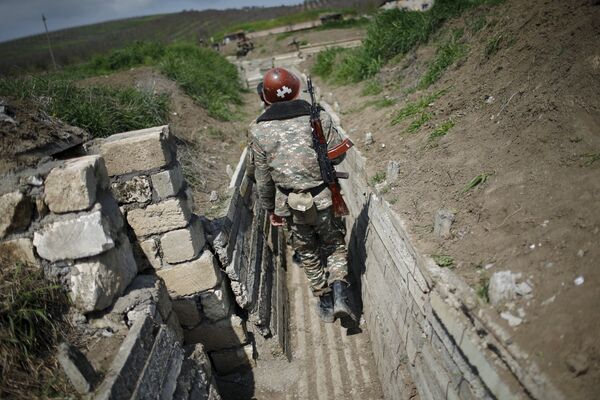In the early morning of February 25, there was a serious breach of the agreed on the Line of Contact, the heavily militarized deadzone that separates the two countries' trenches. The skirmish produced several fatalities. Both Armenia and Azerbaijan accuse each other of an incursion attempt, but without international monitors at the scene, it's difficult to tell who fired first — and why.

Armenia claim Azerbaijan provoked the clash, by sending reconnaissance units over the Line, and deploying tanks. Azerbaijan alleges Armenia in fact started it, and they were forced to destroy an Armenian artillery position and drone. Whatever the truth of the matter, the fighting fell with the 25th anniversary of a massacre in the village of Khojaly, in which Armenian forces killed over 160 Azerbaijani people.
Moreover, it's was the largest flare-up in violence since the four-day war between the two sides in April 2016 that claimed several hundred lives on both sides. Since then, a ceasefire has been agreed, although the two sides have continued to trade artillery and sniper fire on an almost daily basis.
Richard Giragosian, director of the Regional Studies Center in Yerevan, notes Azerbaijan Defense Minister Zakir Hasanov and army chief of staff, General Nejmeddin Sadiqov, visited the Line two days prior to the mêlée, and instructed Azerbaijani frontline troops to take "tougher and more resolute measures" in response to what they called growing Armenian "provocations."
"The Azerbaijani operation was more than the usual probe of defensive positions, and involved a targeted mission to conduct more in-depth reconnaissance after overcoming a small minefield. The operation was fairly quickly discovered, however, and resulted in at least five Azerbaijani casualties before being fully repulsed in a more serious counteroffensive," Mr. Giragosian told Sputnik.
He added that such violations have steadily intensified since the start of 2017, with both sides accusing each other of using mortars and rocket-propelled grenades on a virtually daily basis. The risk of renewed hostilities is "clearly escalating," he said, and a repeat offensive by Azerbaijani forces "is ever more likely."
"Similar to the April 2016 offensive, the temptation for Azerbaijan to seek a repeat military success, aimed at seizing and securing territory, combined with effective distraction from Azerbaijan's domestic economic problems, suggest a dangerous and destabilizing fresh round of fighting. However, there are two factors that will limit the potential gains from any renewed offensive. The element of surprise is no longer an advantage, and second, the defending Armenian and Karabakh sides are better equipped to repulse any attack," Mr. Giragosian told Sputnik.
Therefore, Mr. Giragosian believes, the next round of fighting may be even more deadly, as the Azerbaijani offensive will quickly stall, leading to a protracted battle of attrition that may trigger the deployment and use of more deadly offensive weapon systems, such as artillery, multiple launch missile launchers and air power.
"Sadly, as diplomacy remains deadlocked, there is no real deterrence to such a scenario," he concluded.
Conversely, other observers have suggested the confrontation was instigated by Armenian provocations. Turkey's Foreign Ministry condemned "heavy weapon attacks carried out against Azerbaijan", and said Armenia had kept one-fifth of Azerbaijani territory "under occupation for a quarter century."
The dispute over the Karabakh region has its roots in the end of World War I, when the virtually simultaneous collapse of the Ottoman and Russian Empires led to the Caucasus nations of Armenia, Azerbaijan and Georgia forming the 'Transcaucasian Federation.'
Fighting over boundaries soon erupted between the trio, and the issue has failed to be resolved since, despite lengthy periods of relatively peaceful coexistence. International bodies typically recognize the area as part of Azerbaijan, with three UN Security Council Resolutions (853, 874 and 884) referring to it as such, and the Parliamentary Assembly of the Council of Europe classing the region as under Armenian occupation.
Armenian president Serzh Sargsyan is scheduled to meet with EU leaders in Brussels before the end of February, to discuss plans for a slimmed-down EU association treaty after his country opted to join the Russian-led Eurasian Union.






